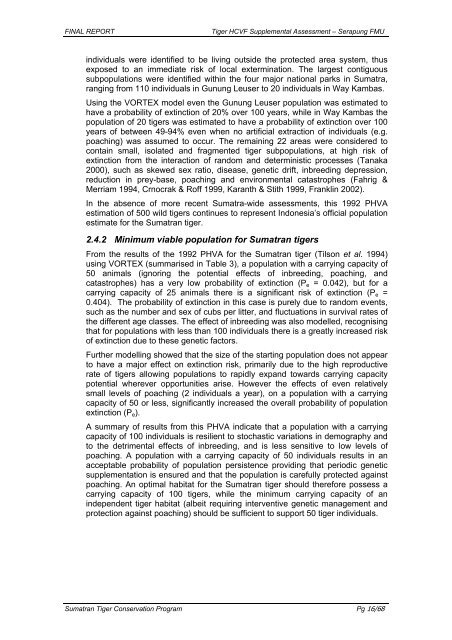A Supplemental HCVF Assessment on the Sumatran Tiger ...
A Supplemental HCVF Assessment on the Sumatran Tiger ...
A Supplemental HCVF Assessment on the Sumatran Tiger ...
Create successful ePaper yourself
Turn your PDF publications into a flip-book with our unique Google optimized e-Paper software.
FINAL REPORT <strong>Tiger</strong> <str<strong>on</strong>g>HCVF</str<strong>on</strong>g> <str<strong>on</strong>g>Supplemental</str<strong>on</strong>g> <str<strong>on</strong>g>Assessment</str<strong>on</strong>g> – Serapung FMU<br />
individuals were identified to be living outside <strong>the</strong> protected area system, thus<br />
exposed to an immediate risk of local exterminati<strong>on</strong>. The largest c<strong>on</strong>tiguous<br />
subpopulati<strong>on</strong>s were identified within <strong>the</strong> four major nati<strong>on</strong>al parks in Sumatra,<br />
ranging from 110 individuals in Gunung Leuser to 20 individuals in Way Kambas.<br />
Using <strong>the</strong> VORTEX model even <strong>the</strong> Gunung Leuser populati<strong>on</strong> was estimated to<br />
have a probability of extincti<strong>on</strong> of 20% over 100 years, while in Way Kambas <strong>the</strong><br />
populati<strong>on</strong> of 20 tigers was estimated to have a probability of extincti<strong>on</strong> over 100<br />
years of between 49-94% even when no artificial extracti<strong>on</strong> of individuals (e.g.<br />
poaching) was assumed to occur. The remaining 22 areas were c<strong>on</strong>sidered to<br />
c<strong>on</strong>tain small, isolated and fragmented tiger subpopulati<strong>on</strong>s, at high risk of<br />
extincti<strong>on</strong> from <strong>the</strong> interacti<strong>on</strong> of random and deterministic processes (Tanaka<br />
2000), such as skewed sex ratio, disease, genetic drift, inbreeding depressi<strong>on</strong>,<br />
reducti<strong>on</strong> in prey-base, poaching and envir<strong>on</strong>mental catastrophes (Fahrig &<br />
Merriam 1994, Crnocrak & Roff 1999, Karanth & Stith 1999, Franklin 2002).<br />
In <strong>the</strong> absence of more recent Sumatra-wide assessments, this 1992 PHVA<br />
estimati<strong>on</strong> of 500 wild tigers c<strong>on</strong>tinues to represent Ind<strong>on</strong>esia’s official populati<strong>on</strong><br />
estimate for <strong>the</strong> <strong>Sumatran</strong> tiger.<br />
2.4.2 Minimum viable populati<strong>on</strong> for <strong>Sumatran</strong> tigers<br />
From <strong>the</strong> results of <strong>the</strong> 1992 PHVA for <strong>the</strong> <strong>Sumatran</strong> tiger (Tils<strong>on</strong> et al. 1994)<br />
using VORTEX (summarised in Table 3), a populati<strong>on</strong> with a carrying capacity of<br />
50 animals (ignoring <strong>the</strong> potential effects of inbreeding, poaching, and<br />
catastrophes) has a very low probability of extincti<strong>on</strong> (Pe = 0.042), but for a<br />
carrying capacity of 25 animals <strong>the</strong>re is a significant risk of extincti<strong>on</strong> (Pe =<br />
0.404). The probability of extincti<strong>on</strong> in this case is purely due to random events,<br />
such as <strong>the</strong> number and sex of cubs per litter, and fluctuati<strong>on</strong>s in survival rates of<br />
<strong>the</strong> different age classes. The effect of inbreeding was also modelled, recognising<br />
that for populati<strong>on</strong>s with less than 100 individuals <strong>the</strong>re is a greatly increased risk<br />
of extincti<strong>on</strong> due to <strong>the</strong>se genetic factors.<br />
Fur<strong>the</strong>r modelling showed that <strong>the</strong> size of <strong>the</strong> starting populati<strong>on</strong> does not appear<br />
to have a major effect <strong>on</strong> extincti<strong>on</strong> risk, primarily due to <strong>the</strong> high reproductive<br />
rate of tigers allowing populati<strong>on</strong>s to rapidly expand towards carrying capacity<br />
potential wherever opportunities arise. However <strong>the</strong> effects of even relatively<br />
small levels of poaching (2 individuals a year), <strong>on</strong> a populati<strong>on</strong> with a carrying<br />
capacity of 50 or less, significantly increased <strong>the</strong> overall probability of populati<strong>on</strong><br />
extincti<strong>on</strong> (Pe).<br />
A summary of results from this PHVA indicate that a populati<strong>on</strong> with a carrying<br />
capacity of 100 individuals is resilient to stochastic variati<strong>on</strong>s in demography and<br />
to <strong>the</strong> detrimental effects of inbreeding, and is less sensitive to low levels of<br />
poaching. A populati<strong>on</strong> with a carrying capacity of 50 individuals results in an<br />
acceptable probability of populati<strong>on</strong> persistence providing that periodic genetic<br />
supplementati<strong>on</strong> is ensured and that <strong>the</strong> populati<strong>on</strong> is carefully protected against<br />
poaching. An optimal habitat for <strong>the</strong> <strong>Sumatran</strong> tiger should <strong>the</strong>refore possess a<br />
carrying capacity of 100 tigers, while <strong>the</strong> minimum carrying capacity of an<br />
independent tiger habitat (albeit requiring interventive genetic management and<br />
protecti<strong>on</strong> against poaching) should be sufficient to support 50 tiger individuals.<br />
<strong>Sumatran</strong> <strong>Tiger</strong> C<strong>on</strong>servati<strong>on</strong> Program Pg 16/68

















